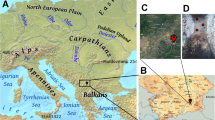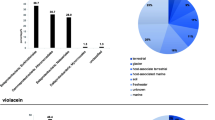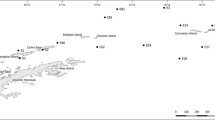Abstract
Microbes in hydrothermal vents with their unique secondary metabolism may represent an untapped potential source of new natural products. In this study, samples were collected from the hydrothermal field of Kolumbo submarine volcano in the Aegean Sea, in order to isolate bacteria with antimicrobial activity. Eight hundred and thirty-two aerobic heterotrophic bacteria were isolated and then differentiated through BOX-PCR analysis at the strain level into 230 genomic fingerprints, which were screened against 13 different type strains (pathogenic and nonpathogenic) of Gram-positive, Gram-negative bacteria and fungi. Forty-two out of 176 bioactive-producing genotypes (76 %) exhibited antimicrobial activity against at least four different type strains and were selected for 16S rDNA sequencing and screening for nonribosomal peptide (NRPS) and polyketide (PKS) synthases genes. The isolates were assigned to genus Bacillus and Proteobacteria, and 20 strains harbored either NRPS, PKS type I or both genes. This is the first report on the diversity of culturable mesophilic bacteria associated with antimicrobial activity from Kolumbo area; the extremely high proportion of antimicrobial-producing strains suggested that this unique environment may represent a potential reservoir of novel bioactive compounds.




Similar content being viewed by others
References
Austin B (1988) Marine microbiology. Cambridge University Press, New York
Blunt JW, Copp BR, Keyzers RA, Munro MHG, Prinsep MR (2014) Marine natural products. Nat Prod Rep 31:160–258
Carey S, Croff Bell KL, Nomikou P, Vougioukalakis G, Roman CN, Cantner K, Bejelou K, Bourbouli M, Fero Martin J (2011) Exploration of the Kolumbo rift zone. In: Bell KLC, Fuller SA (eds) New frontiers in ocean exploration: the E/V Nautilus 2010 Field Season, Oceanography, Supplement, vol 24, pp 24–25
Castro da Silva MA, Cavalett A, Spinner A, Rosa DC, Jasper RB, Quecine MC, Bonatelli ML, Pizzirani-Kleiner A, Corção G, Oliveira de Souza Lima A, Lima A (2013) Phylogenetic identification of marine bacteria isolated from deep-sea sediments of the eastern South Atlantic Ocean. Springerplus 2:127–137
Cottrell MT, Kirchman DL (2000) Community composition of marine bacterioplankton determined by 16S rRNA gene clone libraries and fluorescence in situ hybridization. Appl Environ Microbiol 66:5116–5122
Devereux R, Wilkinson S (2004) Identification and classification of microbes using DNA and RNA sequences. In: Kowalchuk GA, de Bruijn FJ, Head IM, Akkermans AD, van Elsas JD (eds) Molecular microbial ecology manual. Kluwer Academic Publishers, the Netherlands, pp 509–850
Dick GJ, Lee YE, Tebo BM (2006) Manganese (II)-oxidizing Bacillus Spores in Guaymas Basin hydrothermal sediments and plumes. Appl Environ Microbiol 72:3184–3190
Du L, Lou L (2010) PKS and NRPS release mechanisms: review. Nat Prod Rep 27:255–278
Fickers P (2012) Antibiotic compounds from Bacillus: why are they so amazing? Am J Biochem Biotechnol 8:40–46
Fischbach MA, Walsh CT (2006) Assembly-line enzymology for polyketide and nonribosomal peptide antibiotics: logic, machinery, and mechanisms. Chem Rev 106:3468–3496
Fischbach MA, Walsh CT (2009) Antibiotics for emerging pathogens. Science 325:1089–1093
Gärtner A, Blumel M, Wiese J, Imhoff JF (2011) Isolation and characterization of bacteria from the Eastern Mediterranean deep sea. A van Leeuw J Microb 100:421–435
Gerwick WH, Fenner AM (2013) Drug discovery from marine microbes. Microb Ecol 65:800–806
Gontang EA, Fenical W, Jensen PR (2007) Phylogenetic diversity of Gram-positive bacteria cultured from marine sediments. Appl Environ Microbiol 73:3272–3282
Gulder TAM, Moore BS (2009) Chasing the treasures of the sea-bacterial marine natural products. Curr Opin Microbiol 12:252–260
Homann VV, Sandy M, Tincu JA, Templeton AS, Tebo BM, Butler AJ (2009) Loihechelins A–F, a suite of amphiphilic siderophores produced by the marine bacterium Halomonas LOB-5. J Nat Prod 72:884–888
Inagaki F, Suzuki M, Takai K, Oida H, Sakamoto T, Aoki K, Nealson KH, Horikoshi K (2003) Microbial communities associated with geological horizons in coastal subseafloor sediments from the Sea of Okhotsk. Appl Environ Microbiol 9:7224–7235
Joint I, Muhling M, Querellou J (2010) Culturing marine bacteria: an essential prerequisite for biodiscovery. Microb Biotechnol 3:564–575
Kato C, Li L, Tamaoka J, Horikoshi K (1997) Molecular analyses of the sediment of the 11,000-m deep Mariana Trench. Extremophiles 1:17–23
Kaye JZ, Baross JA (2000) High incidence of halotolerant bacteria in Pacific hydrothermal-vent and pelagic environments. FEMS Microbiol Ecol 32:249–260
Kilias SP, Nomikou P, Papanikolaou D, Polymenakou PN, Godelitsas A, Argyraki A, Carey S, Gamaletsos P, Mertzimekis TJ, Stathopoulou E, Goettlicher J, Steininger R, Betzelou K, Livanos I, Christakis C, Bell KC, Scoullos M (2013) New insights into hydrothermal vent processes in the unique shallow-submarine arc-volcano, Kolumbo (Santorini), Greece. Nat Sci Rep 3:2421
Kontro M, Lignell U, Hirvonen M-R, Nevalainen A (2005) pH effects on 10 Streptomyces spp. growth and sporulation depend on nutrients. Lett Appl Microbiol 41:32–38
Kopp F, Marahiel MA (2007) Macrocyclization strategies in polyketide and nonribosomal peptide biosynthesis: review. Nat Prod Rep 24:735–749
Laatsch H (2006) Marine bacterial metabolites. In: Proksch P, Müller WEG (eds) Frontiers in marine biotechnology. Horizon Bioscience, Norfolk, pp 225–288
Li L, Kato C, Horikoshi K (1999) Bacterial diversity in deep-sea sediments from different depths. Biodivers Conserv 8:659–677
Liu Y, Lai Q, Dong Ch, Sun F, Wang L, Li G, Shao Z (2013) Phylogenetic diversity of the Bacillus pumilus group and the marine ecotype revealed by multilocus sequence analysis. PLoS One 8:e80097
Long RA, Azam F (2001) Antagonistic interactions among marine pelagic bacteria. Appl Environ Microbiol 67:4975–4983
Matz C, Webb JS, Schupp PJ, Phang SY, Penesyan A, Egan S (2008) Marine biofilm bacteria evade eukaryotic predation by targeted chemical defense. PLoS One 3:e2744
Mayer AMS, Rodríguez AD, Taglialatela-Scafati O, Fusetani N (2013) Marine pharmacology 2009–2011: marine compounds with antibacterial, antidiabetic, antifungal, anti-inflammatory, antiprotozoal, antituberculosis and antiviral activities; affecting the immune and nervous systems, and other miscellaneous mechanisms of action. Mar Drugs 11:2510–2573
Mohandass C, Rajasabapathy R, Ravindran C, Colaco A, Santos RS, Meena RM (2012) Bacterial diversity and their adaptations in the shallow water hydrothermal vent at D. João de Castro Seamount (DJCS), Azores, Portugal. Cah Biol Mar 53:65–76
Moore E, Arnscheidt A, Kruger A, Strompl C, Mau M (2004) Simplified protocols for the preparation of genomic DNA from bacterial cultures. In: Kowalchuk GA, de Bruijn FJ, Head IM, Akkermans AD, van Elsas JD (eds) Molecular microbial ecology manual, 2nd edn. Kluwer Academic Publishers, the Netherlands, pp 3–18
Newman DJ, Cragg GM (2007) Natural products as sources of new drugs over the last 25 years. J Nat Prod 70:461–477
Nguyen TA, Ishida K, Jenke-Kodama H, Dittmann E, Gurgui C, Hochmuth T, Taudien S, Platzer M, Hertweck C, Piel J (2008) Exploiting the mosaic structure of trans-acyltransferase polyketide synthases for natural product discovery and pathway dissection. Nat Biotechnol 26:225–233
Nithya Ch, Pandian ShK (2010) Isolation of heterotrophic bacteria from Palk Bay sediments showing heavy metal tolerance and antibiotic production. Microbiol Res 165:578–593
Olins HC, Rogers DR, Frank KL, Vidoudez C, Girguis PR (2013) Assessing the influence of physical, geochemical and biological factors on anaerobic microbial primary productivity within hydrothermal vent chimneys. Geobiology 11:279–293
Pathom-aree W, Stach JEM, Ward AC, Horikoshi K, Bull AT, Goodfellow M (2006) Diversity of actinomycetes isolated from challenger deep sediment (10,898 m) from the Mariana Trench. Extremophiles 56:181–189
Penesyan A, Marshall-Jones Z, Holmstrom C, Kjelleberg S, Egan S (2009) Antimicrobial activity observed among cultured marine epiphytic bacteria reflects their potential as a source of new drugs. FEMS Microbiol Ecol 69:113–124
Penesyan A, Kjelleberg S, Egan S (2010) Development of novel drugs from marine surface associated microorganisms. Mar Drugs 8:438–459
Pettit RK (2011) Culturability and secondary metabolite diversity of extreme microbes: expanding contribution of deep-sea and deep-sea vent microbes to natural product discovery. Mar Biotechnol 13:1–11
Piel J (2010) Biosynthesis of polyketides by trans-AT polyketide synthases. Nat Prod Rep 27:996–1047
Prieur D (2005) Microbiology of deep-sea hydrothermal vents: lessons for Mars exploration. In: Tokano T (ed) Water on mars and life. Springer, Berlin, pp 299–324
Quigley MM, Colwell JRR (1968) Properties of bacteria isolated from deep-sea sediments. J Bacteriol 95:211–220
Rademaker JLW, Louws FJ, Versalovic J, de Bruijn FJ (2004) Characterization of the diversity of ecologically important microbes by rep-PCR genomic fingerprinting. In: Kowalchuck GA, de Bruijn FG, Head IM, Akkermans AD, van Elsas JD (eds) Molecular microbial ecology manual, 2nd edn. Kluwer Academic Publishers, Dordrecht, pp 1–33
Reva O, Tummler B (2008) Think big-giant genes in bacteria. Environ Microbiol 10:768–777
Rodriguez L, Banat IM, Teixeira J, Rosario O (2006) Biosurfactants: potential applications in medicine. J Antimicrob Chemother 57:609–618
Roongsawang N, Washio K, Morikawa M (2011) Diversity of nonribosomal peptide synthetases involved in the biosynthesis of lipopeptide biosurfactants. Int J Mol Sci 12:141–172
Schwarzer D, Finking R, Marahiel MA (2003) Nonribosomal peptides: from genes to products. Nat Prod Rep 20:275–287
Senni K, Gueniche F, Changotade S, Septier D, Sinquin C, Ratiskol J, Lutomski D, Godeau G, Guezennec J, Colliec-Jouault S (2013) Unusual glycosaminoglycans from a deep sea hydrothermal bacterium improve fibrillar collagen structuring and fibroblast activities in engineered connective tissues. Mar Drugs 11:1351–1369
Skropeta D (2008) Deep-sea natural products. Nat Prod Rep 25:1131–1166
Sogin ML, Morrison HG, Huber JA, Welch DM, Huse SM, Neal PR, Arrieta JM, Herndl GJ (2006) Microbial diversity in the deep sea and the underexplored “rare biosphere”. PNAS 103:12115–12120
Stein T (2005) Bacillus subtilis antibiotics: structures, syntheses and specific functions. Mol Microbiol 56:845–857
Tamura K, Stecher G, Peterson D, Filipski A, Kumar S (2013) Mega 6: molecular evolutionary genetics analysis using maximum likelihood, evolutionary distance, and maximum parsimony methods, version 6.0. Mol Biol Evol 30:2725–2729
Tarasov VG, Gebruk AV, Mironov AN, Moskalev LI (2005) Deep-sea and shallow-water hydrothermal vent communities: two different phenomena? Chem Geol 224:5–39
Thornburg CC, Zabriskie TM, McPhail KL (2010) Deep-sea hydrothermal vents: potential hot spots for natural products discovery? J Nat Prod 73:489–499
Van Dover CL, German CR, Speer KG, Parson LM, Vrijenhoek RC (2002) Evolution and biogeography of deep-sea vent and seep invertebrates. Science 295:1253–1257
Wagner-Dobler I, Rheims H, Felske A, El-Ghezal A, Flade-Schroder D, Laatsch H, Lang S, Pukall R, Tindall BJ (2004) Oceanibulbus indolifex gen. nov., sp. nov., a North Sea alpha proteobacterium that produces bioactive metabolites. Int J Syst Evol Microbiol 54:1177–1184
Wilson ZE, Brimble MA (2009) Molecules derived from the extremes of life. Nat Prod Rep 26:44–71
Xu M, Miao L, Li X-C, Xiao X, Qian P-Y (2007) Antibacterial and antilarval activity of deep-sea bacteria from sediments of the West Pacific Ocean. Biofouling 23:131–137
Zhang W, Zhang F, Li Z, Miao X, Meng Q, Zhang X (2008) Investigation of bacteria with polyketide synthase genes and antimicrobial activity isolated from South China Sea sponges. J Appl Microbiol 107:567–575
Zhang W, Li Z, Miao X, Zhang F (2009) The screening of antimicrobial bacteria with diverse novel nonribosomal peptide synthetase (NRPS) genes from South China Sea sponges. Mar Biotechnol 11:346–355
Zheng L, Han XT, Chen HM, Lin W, Yan XJ (2005) Marine bacteria associated with marine macroorganisms: the potential antimicrobial resources. Ann Microbiol 55:119–124
Acknowledgments
We thank Prof. Steven Carey and Dr. Katherine L. Croff Bell (Chief Scientist) for inviting us to participate in the E/V Nautilus 2010 expedition, the crew of E/V Nautilus and the pilots of the remotely operated vehicle Hercules for their help in obtaining the samples. We also thank the members of Microbiology Group Prof. George Dialinas, Dr. Alexandros Savvidis and Dr. Sotiris Amillis for their precious help. This research has been co-financed by the European Union (European Social Fund—ESF) and Greek national funds through the Operational Program “Education and Lifelong Learning” of the National Strategic Reference Framework (NSRF)—Research Funding Program: Heracleitus II.
Author information
Authors and Affiliations
Corresponding author
Additional information
Communicated by Erko Stackebrandt.
Rights and permissions
About this article
Cite this article
Bourbouli, M., Katsifas, E.A., Papathanassiou, E. et al. The Kolumbo submarine volcano of Santorini island is a large pool of bacterial strains with antimicrobial activity. Arch Microbiol 197, 539–552 (2015). https://doi.org/10.1007/s00203-015-1086-3
Received:
Revised:
Accepted:
Published:
Issue Date:
DOI: https://doi.org/10.1007/s00203-015-1086-3




